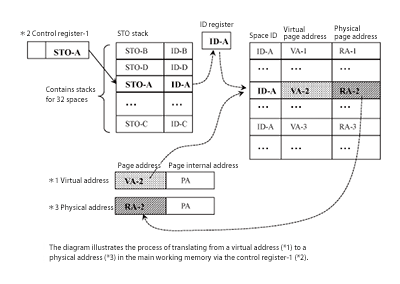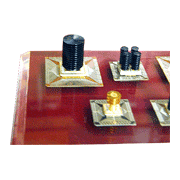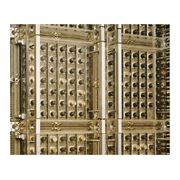The FACOM M-100 series was the first large mainframe series under Fujitsu’s FACOM M series of mainframes. The series was announced in November 1974. The series had three models: the very-large FACOM M-190 and the large FACOM M-180II and FACOM M-160. The primary characteristics of this series are given below.
- (1)IBM S/370 architecture
- It employed the international standard IBM S/370 for its basic architecture.
- (2)Large scale integrated circuits (LSI)
- Using LSI throughout, it achieved an outstanding cost-performance ratio and high performance, while reducing power and space. The LSI was at the highest level in the world for practical devices, with a maximum of 100 gates per chip, and an average on-chip delay time per gate of 700 picoseconds. By using such LSI throughout the system, this series achieved a quantum leap in processing speed, while improving reliability and achieving power and space savings
- (3)High-speed address translation architecture
- The M-100 series was equipped with a translation lookaside buffer (TLB), a hardware module for translating the series’ 16-megabyte virtual address space into physical addresses at high speeds. The series also came with a segment table origin (STO) stack to handle at high speeds the multiple virtual storage spaces supported by mainframe operating systems. (See Figure 1.)
- (4)Dynamic address translation (DAT) channel architecture
- The DAT channel architecture made it possible to read and write data from I/O devices directly to virtual memory spaces, resulting in a five to 20 percent improvement in system performance compared to if DAT channel architecture were not used. Online systems, in particular, benefited greatly from this architecture.
- (5)Service processor (SVP)
- In addition to hardware-based functions for auto recovery and auto correction, the M-100 series came with a SVP independent of the main CPU to enhance the machines’ reliability, availability, and serviceability functions. The SVP’s specific functions are as follows.
- Console functions for the operating system.
- Operation panel functions: The main panel on FACOM M-100 series machines had almost no lights or switches, so this function was used to operate the computer using a display device connected to the SVP.
- Maintenance panel functions: Service personnel (customer engineers) made use of the operational status information and test tools available from the SVP.
- Remote maintenance functions: The SVP could be connected to a service center by a communication line.
- (6)Software for online databases
- M-100 series machines were furnished with the Advanced Information Manager (AIM), a comprehensive online database management software package that closely integrated the functions of an online network and the functions of a sophisticated database.




